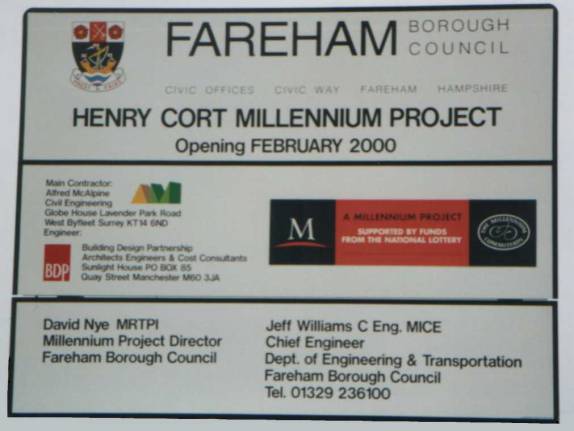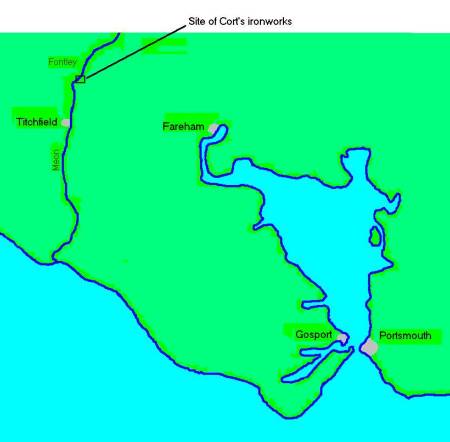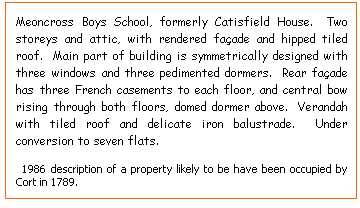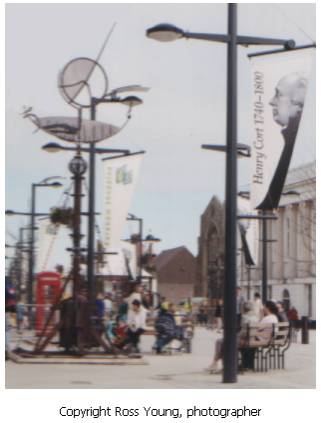 |
 |
Henry Cort Inventor - Creator of puddled iron - Father of iron trade |
 |
 |
| This page is part of a website based on the life and achievements of eighteenth-century inventor Henry Cort. The creator and owner of the site was Eric Alexander who passed away. The site is now hosted by Geneagraphie.com Please contact us with any comments or queries. |
- Homepage
- Life of Henry Cort
- Cort's processes in iron manufacture
- Cort's patents
- Refutation of allegations of conspiracies against Cort
- Adam Jellicoe's death
- Henry Cort's birth
- A navy agent's business
- Early life of John Becher
- Attwick & Burges families
- "Cortship" of second wife
- Thomas Morgan
- Henry Cort's hoops contract
- 1856 Accolade
- Generosity of friends 1789-94
- James Watson
- Illness of Cort's son
- Main sources of information
- Contemporary sources
- Navy sources
- Chancery files
- Publications about Cort
- Assessment of Cort's character
- Images of Henry Cort
Impeach-tranferred to 05
- Parliamentary inquiry 1811-2
- The furore of the 1850s
- Society of Arts
- Cort's first marriage
- Henry Cort's children
- Cort family pensions
- Henry Cort's Hertfordshire property
- 1791 signatories
- Guiana and the Cort-Gladstone connection
- Cort's twilight years
- Memorials to Henry Cort
- Smelting of iron
- Fining before Cort
- Shropshire & Staffordshire ironmasters
- Cumbrians: Wilkinson etc
- Early works at Merthyr Tydfil
- The Crowley business
- London ironmongers
- Scottish iron
- Cort's promotion efforts 1783-6
- Later Merthyr connections
- Puddling after Henry Cort
- Gosport in Cort's day
- Gosport administration
- Gosport worthies
- The Amherst-Porter network
- James Hackman, murderer
- Samuel Marshall
- Samuel Jellicoe's legacy
- Links with Titchfield
- Links with Fareham
- Fact, error and conjecture
- 18th century politics
- Law in the 18th century
- 18th century finance
- Religion and sexual mores
- Calendar change of 1752
- Shelburne, Parry and associates
- John Becher's family
- The Becher-Thackeray lineage
- Thomas Lyttelton: a fantastic narrative
- Eighteenth-century London
- Abolition and the Corts
- The Burges will tangle
- Navy connections
- Navy agent's business
- Cort's clients
- Ships' pursers
- History of Adam Jellicoe
- Dundas & Trotter
- Cort's navy office associates
- Toulmin & other agents
- Sandwich & Middleton
- The Arethusa
- John Becher's war
- Thomas Morgan's war
- The 1782 Jamaica convoy
- Sinking of the Royal George
- Visitors 2006-2009
- Developement of the site 2006-2009
- Daniel Guion and family
- Extremely bad academic work and extremely bad journalism
****************
|
|
Cort's links with Fareham

Fareham's first connection with Cort is as a point on his route from Gosport, where he already rents a wharf.
He needs to take raw materials to his mill at Fontley, and bring back the material he makes there.
 By the creek at Fareham he finds "a large and commodious quay" built by the last of the Gringos on "two acres of mudlands" in 1737. This quay, which Cort rents at £25 per year, now belongs to Peter Barfoot (who may be the same Peter Barfoot who later retires to nearby Droxford and combines with Hampshire Chronicle proprietor John Wilkes to produce the Universal British Directory).
By the creek at Fareham he finds "a large and commodious quay" built by the last of the Gringos on "two acres of mudlands" in 1737. This quay, which Cort rents at £25 per year, now belongs to Peter Barfoot (who may be the same Peter Barfoot who later retires to nearby Droxford and combines with Hampshire Chronicle proprietor John Wilkes to produce the Universal British Directory).
From Barfoot's quay the goods travel overland some three miles through Fareham. The route can still be traced, though the last mile passes along an exceedingly muddy track and requires a detour to cross the M27.
In the 1780s Cort is dragged into a dispute over the quay. Barfoot accuses the trustees of the Fareham turnpike of encroaching on his land while widening the causeway over Fareham Creek from 15 to 38 feet.
This land includes the quay that Cort has been renting: the encroachment has discouraged him, Barfoot says, from accepting renewal of the lease.
In June 1785 Barfoot's workmen attempt to demolish part of the causeway, provoking the trustees to take legal action against him.
After much wrangling, an "inquisition" is held in September 1786. Cort, "the ingenious and celebrated iron founder", is called to testify.
His evidence is hardly helpful to Barfoot. Having paid £25 per year during the lease's five-year term, he is faced with an increase. He declines to renew.
Whether this decision is really influenced by loss of amenity due to the trustees' encroachment is not evident.
 Barfoot's own account of this dispute is held at Hampshire Record Office. It is the only document seen so far containing the names of both Cort and Samuel Marshall, said by Barfoot to be a turnpike trustee. Marshall's latest command, the Pegase, is anchored near Portsmouth most of the time the dispute is running.
Barfoot's own account of this dispute is held at Hampshire Record Office. It is the only document seen so far containing the names of both Cort and Samuel Marshall, said by Barfoot to be a turnpike trustee. Marshall's latest command, the Pegase, is anchored near Portsmouth most of the time the dispute is running.
Meanwhile Cort's sister-in-law Ann Becher has moved to Fareham (probably to the house in High Street where Thackeray meets her some 30 years later. Around the same time Cort moves from Gosport to Catisfield (now on the western fringe of Fareham, about a mile from the Fontley works). An inventory of the Catisfield house appears among the properties investigated by the inquisitions of 1789.
It is likely that Cort's partner Samuel Jellicoe and his family move into the Gosport property vacated by Cort.
The next link we know of is late in the 20th century, when Hampshire County Council renames the Fareham school closest to the Fontley site "Henry Cort Community School" (now "Community College").
As the millennium approaches, Fareham Borough Council seeks a project to win money to support the refurbishment of West Street. They plan to commemorate Henry Cort with work in wrought iron, made by blacksmiths.
The Millennium Commission agrees to support the project.
Artists from all over Europe are invited to submit designs. Eleven entries are accepted.


So begins my connection with Henry Cort. I have been writing about blacksmiths' work, and have served three years as magazine editor for the British Artist Blacksmiths Association. I know some of the artists chosen.
I ask the council: would they like a book about the project?
The result, West Street Trail, emerges in June 2000.
And I set off on my own trail down the Henry Cort road.
|
Related files |
The pages on this site are copied from the original site of Eric Alexander (henrycort.net) with his allowance.
Eric passed away abt 2012
If you use/copy information from this site, please include a link to the page where you found the information.
